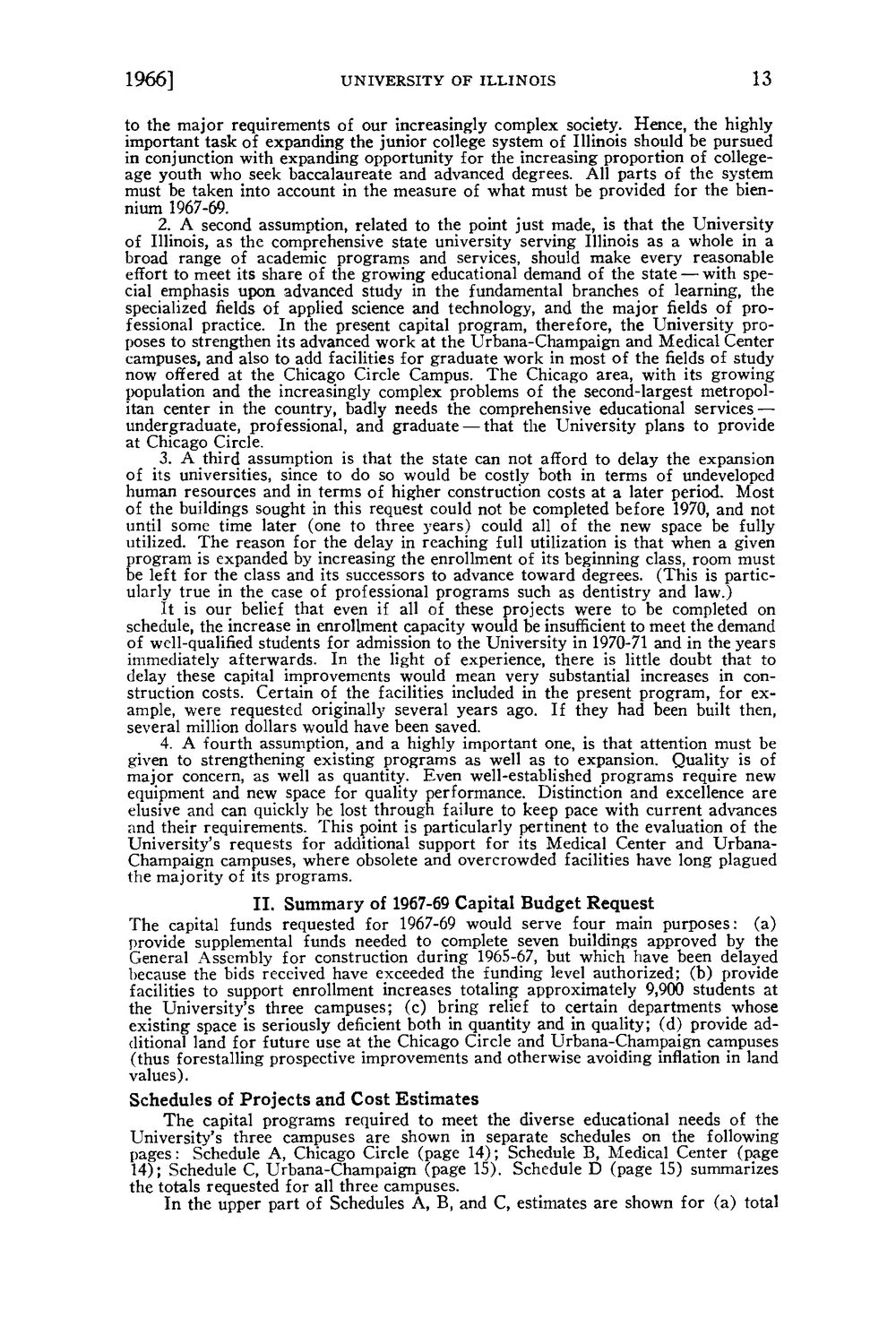| |
| |
Caption: Board of Trustees Minutes - 1968
This is a reduced-resolution page image for fast online browsing.

EXTRACTED TEXT FROM PAGE:
1966] UNIVERSITY OF ILLINOIS 13 to the major requirements of our increasingly complex society. Hence, the highly important task of expanding the junior college system of Illinois should be pursued in conjunction with expanding opportunity for the increasing proportion of collegeage youth who seek baccalaureate and advanced degrees. All parts of the system must be taken into account in the measure of what must be provided for the biennium 1967-69. 2. A second assumption, related to the point just made, is that the University of Illinois, as the comprehensive state university serving Illinois as a whole in a broad range of academic programs and services, should make every reasonable effort to meet its share of the growing educational demand of the state — with special emphasis upon advanced study in the fundamental branches of learning, the specialized fields of applied science and technology, and the major fields of professional practice. In the present capital program, therefore, the University proposes to strengthen its advanced work at the Urbana-Champaign and Medical Center campuses, and also to add facilities for graduate work in most of the fields of study now offered at the Chicago Circle Campus. The Chicago area, with its growing Imputation and the increasingly complex problems of the second-largest metropolitan center in the country, badly needs the comprehensive educational services — undergraduate, professional, and graduate — that the University plans to provide at Chicago Circle. 3. A third assumption is that the state can not afford to delay the expansion of its universities, since to do so would be costly both in terms of undeveloped human resources and in terms of higher construction costs at a later period. Most of the buildings sought in this request could not be completed before 1970, and not until some time later (one to three years) could all of the new space be fully utilized. T h e reason for the delay in reaching full utilization is that when a given program is expanded by increasing the enrollment of its beginning class, room must be left for the class and its successors to advance toward degrees. (This is particularly true in the case of professional programs such as dentistry and law.) It is our belief that even if all of these projects were to be completed on schedule, the increase in enrollment capacity would be insufficient to meet the demand of well-qualified students for admission to the University in 1970-71 and in the years immediately afterwards. In the light of experience, there is little doubt that to delay these capital improvements would mean very substantial increases in construction costs. Certain of the facilities included in the present program, for example, were requested originally several years ago. If they had been built then, several million dollars would have been saved. 4. A fourth assumption, and a highly important one, is that attention must be given to strengthening existing programs as well as to expansion. Quality is of major concern, as well as quantity. Even well-established programs require new equipment and new space for quality performance. Distinction and excellence are elusive and can quickly be lost through failure to keep pace with current advances and their requirements. This point is particularly pertinent to the evaluation of the University's requests for additional support for its Medical Center and UrbanaChampaign campuses, where obsolete and overcrowded facilities have long plagued the majority of its programs. II. Summary of 1967-69 Capital Budget Request The capital funds requested for 1967-69 would serve four main purposes: (a) provide supplemental funds needed to complete seven buildings approved by the General Assembly for construction during 1965-67, but which have been delayed because the bids received have exceeded the funding level authorized; (b) provide facilities to support enrollment increases totaling approximately 9,900 students at the University's three campuses; (c) bring relief to certain departments whose existing space is seriously deficient both in quantity and in quality; (d) provide additional land for future use at the Chicago Circle and Urbana-Champaign campuses (thus forestalling prospective improvements and otherwise avoiding inflation in land values). Schedules of Projects and Cost Estimates T h e capital programs required to meet the diverse educational needs of the University's three campuses are shown in separate schedules on the following pages: Schedule A, Chicago Circle (page 14); Schedule B, Medical Center (page 14); Schedule C, Urbana-Champaign (page 15). Schedule D (page 15) summarizes the totals requested for all three campuses. In the upper part of Schedules A, B, and C, estimates are shown for (a) total
| |